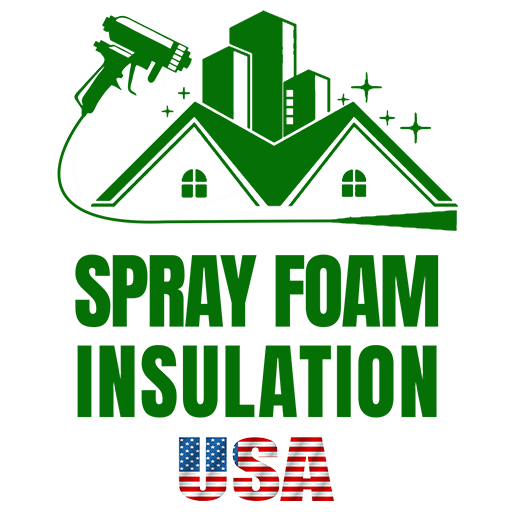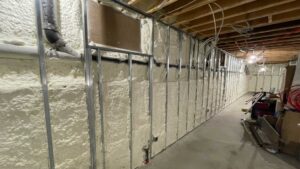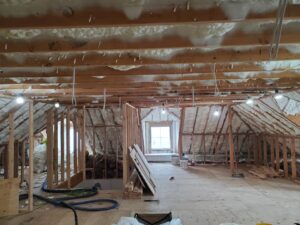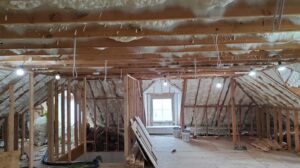Introduction
If you’re on the hunt for insulation options, cellulose insulation might just be what you need. It’s eco-friendly, enhances home comfort, and is perfect for both homeowners and business owners in NY and NJ looking for a green, efficient way to insulate their spaces. With a nod to quality, expertise, and sustainable practices, cellulose insulation stands out as a wise choice for reducing energy bills and boosting comfort all year round.
Cellulose insulation is a plant fiber used in walls and roofs to keep your space warm in winter and cool in summer, reduce noise, and cut down on energy costs. It’s made mostly from recycled paper, treated with fire retardants, making it a win for the environment.
Quick Facts:
– Eco-friendly: Made from up to 85% recycled paper.
– Efficient: High R-value means better heat retention.
– Safe: Treated with fire retardants for your peace of mind.
– Versatile: Perfect for new constructions and retrofit projects.
Whether you’re renovating an old home or building a new one, choosing cellulose insulation means investing in the comfort of your space and the health of our planet.

What is Cellulose Insulation?
When we talk about keeping our homes warm in the winter and cool in the summer, insulation is the hero behind the scenes. And one of the most effective, eco-friendly options out there is cellulose insulation. Let’s dive into what makes it so special.
Plant Fiber: At its core, cellulose insulation is made from plant fibers, primarily recycled paper products like newspapers. This not only gives old paper a new lease on life but also significantly reduces waste.
Wall and Roof Cavities: One of the key places where cellulose shines is in filling up the gaps in wall and roof cavities. It’s like tucking your home into a cozy blanket, ensuring that the warmth stays in during winter and out during the hot summer months.
Noise Reduction: But it’s not just about temperature. Cellulose insulation also plays a big role in reducing noise. Whether it’s the hustle and bustle of the city or just the sound of the wind, cellulose helps keep your home quiet and peaceful.
Here’s a simple breakdown of why cellulose insulation is a smart choice for your home:
- Eco-Friendly: Made from up to 85% recycled material, choosing cellulose is a vote for the planet.
- Energy Efficient: By filling up gaps in walls and roofs, it keeps your home’s temperature steady, which can lower energy bills.
- Soundproofing: Enjoy a quieter home thanks to cellulose’s natural ability to block and absorb sound.
Whether you’re building a new home or upgrading your current one, cellulose insulation offers a blend of comfort, sustainability, and efficiency. It’s a simple way to make a big impact on both your living space and the environment.
Next up, we’ll explore the many benefits of cellulose insulation and why it might just be the perfect choice for your home.
Benefits of Cellulose Insulation
When it comes to insulating your home, cellulose insulation stands out for a variety of reasons. Let’s dive into the key benefits this type of insulation offers, from keeping your home cozy to contributing to a healthier planet.
Thermal Insulation
The primary job of any insulation is to keep your home warm in the winter and cool in the summer. Cellulose insulation excels in this area, thanks to its unique ability to fill in gaps and spaces with a dense, snug fit. This creates a barrier that limits the transfer of heat. In fact, cellulose insulation has an R-Value of between R-3.1 and R-3.8 per inch, making it a highly effective option for maintaining your home’s temperature.
Soundproofing
Noise reduction is another significant advantage of cellulose insulation. Its dense material structure absorbs sounds, helping to create a quieter, more peaceful home environment. Whether it’s street noise, loud neighbors, or other external sounds, cellulose insulation can help dampen the noise, making your home a more serene place to live.
Eco-Friendly
One of the most compelling reasons to choose cellulose insulation is its environmental benefits. Made from up to 85 percent recycled paper, cellulose insulation uses materials that might otherwise end up in landfills. This not only reduces waste but also utilizes a renewable resource, contributing to a more sustainable planet.
Recycled Materials
The high content of recycled materials in cellulose insulation isn’t just good for the planet; it’s also a point of pride for homeowners looking to make eco-conscious choices. By choosing cellulose insulation, you’re directly supporting recycling efforts and reducing the need for new raw materials.
Borate Treatment
Safety is a top concern for many homeowners, and cellulose insulation addresses this with its borate treatment. Borates are minerals that are added to cellulose insulation to make it fire resistant, pest resistant, and mold resistant. This treatment ensures that cellulose insulation not only keeps your home comfortable and efficient but also safe.
In conclusion, cellulose insulation offers a host of benefits that go beyond simple thermal insulation. Its soundproofing qualities can turn your home into a peaceful retreat, its eco-friendly and recycled materials align with sustainable living values, and its safety features provide peace of mind. As we continue to explore insulation options, it’s clear that cellulose insulation presents a compelling choice for homeowners looking to improve their home’s efficiency and comfort while also making a positive impact on the environment.
Next, we’ll look into how cellulose insulation is installed, shedding light on the process and what homeowners can expect.
How Cellulose Insulation is Installed
When you’ve decided that cellulose insulation is the right choice for your home, understanding the installation process is the next step. This section dives into how professionals bring the benefits of cellulose insulation into your living spaces.
Loose-Fill Installation
Loose-fill cellulose is exactly what it sounds like: cellulose in a loose form that is blown into spaces needing insulation. This method is especially effective for attic spaces where it can be distributed evenly across the floor, filling in around joists and other structures without compressing or moving existing insulation.
- The Process: An insulation blower machine, which can often be rented from a local home improvement store, is used to blow the cellulose into place. This method is efficient and allows for cellulose to densely pack into nooks and crannies, providing an effective barrier against heat loss.
Wet-Applied Installation
In areas where loose-fill might not be suitable, or when adding insulation to new construction, wet-applied cellulose is an option. This method involves adding a small amount of moisture to the cellulose as it’s sprayed. This helps the cellulose stick to vertical surfaces without sagging or falling out before it dries.
- The Process: A specialized machine mixes the cellulose with water and then sprays it into open wall cavities, onto basement walls, or under floors. As it dries, it forms a solid, insulative layer that fits perfectly to the space.
Retrofit Insulation
Adding cellulose insulation to existing walls without removing drywall is a common retrofit project to improve a home’s energy efficiency. This is where the true versatility of cellulose shines.
- The Process: Small holes are drilled into the walls from the exterior or interior, depending on what’s most practical. The loose-fill cellulose is then blown into the wall cavities. After the cavities are filled, the holes are patched and made ready for paint or finish.
Blower Application
Whether installing in an attic or within walls, the blower application method is a key part of the process. The equipment used can usually be operated by a homeowner with some DIY skills, but professional installation is recommended to ensure the insulation is evenly distributed and densely packed.
Attic Installation
Installing cellulose insulation in an attic is one of the most straightforward methods of improving a home’s energy efficiency. For attics, the focus is on covering the floor with a thick layer of cellulose, ensuring that it fills the space between and over the joists.
- The Process: Using a blower, the cellulose is spread across the attic floor, paying special attention to areas around vents, pipes, and other protrusions. The goal is to create a uniform layer that covers the entire area without leaving any gaps.
In conclusion, the installation of cellulose insulation, whether through loose-fill, wet-applied methods, or during a retrofit project, is a process that can significantly enhance the comfort and efficiency of your home. While the DIY route is possible with the right equipment and knowledge, professional installation ensures the job is done right, maximizing the benefits of cellulose insulation. With its eco-friendly attributes and excellent insulative properties, cellulose insulation is a choice worth considering for any homeowner looking to upgrade their home’s insulation.
We’ll address some common concerns and solutions associated with cellulose insulation, providing you with a well-rounded understanding of what to expect and how to ensure the longevity and effectiveness of your insulation.
Comparing Cellulose Insulation to Other Types
When looking at cellulose insulation, it’s important to see how it stacks up against other insulation types. Let’s dive into the key areas where cellulose insulation shows its strengths and faces challenges.
R-Value
- Cellulose insulation has an R-Value of about 3.1 to 3.8 per inch. This is a measure of how well it can resist heat flow. The higher the R-Value, the better it is at keeping your home warm in the winter and cool in the summer.
- While this R-Value is competitive, remember that proper installation and density can impact its effectiveness.
Fire Retardant
- A big plus for cellulose insulation is its treatment with borates, giving it a Class I fire safety rating. This means it’s treated to be less flammable, making it a safer choice in the event of a fire.
- This borate treatment not only makes cellulose less of a fire hazard but also helps resist pests.
Moisture Resistance
- One area where cellulose can be at a disadvantage is with moisture. It can absorb moisture, which lowers its R-Value and could lead to mold or mildew if not properly managed.
- However, it’s worth noting that when properly installed, cellulose’s dense pack can limit air movement, reducing the risk of moisture buildup.
Settling
- Over time, cellulose insulation can settle, especially in walls. This can create pockets where insulation isn’t as effective. However, in attics, this is less of an issue as it can be overfilled to account for settling.
- Proper installation techniques can minimize settling and ensure consistent coverage.
Weight
- Cellulose insulation is heavier than some alternatives. This means it’s crucial to ensure that the structure of your home can support the weight, especially if adding insulation to an existing building.
Green Advantages
- A significant benefit of cellulose insulation is its eco-friendliness. It’s made from up to 85 percent recycled paper, making it a sustainable choice. The remaining 15 percent, which includes the borate treatment, might raise some environmental concerns but overall, it’s considered a green option.
- The high recycled content not only reduces waste but also utilizes less energy in manufacturing compared to some other insulation types.
In Summary, cellulose insulation offers a balance of thermal performance, fire resistance, and environmental benefits. While it has its challenges, such as moisture absorption and settling, proper installation and care can mitigate these issues. Its high recycled content and fire retardant treatment make it an attractive option for those looking to insulate their homes in an eco-friendly manner.
As we continue to explore home insulation, it’s clear that cellulose insulation provides a compelling option for many homeowners. Its unique blend of features makes it a contender in the insulation market, offering a mix of safety, eco-friendliness, and energy efficiency.
Next, we’ll delve into some common concerns and solutions regarding cellulose insulation, ensuring you’re equipped with the knowledge to make the best decision for your home.
Common Concerns and Solutions
When considering cellulose insulation for your home, a few common concerns might come to mind. Let’s address these concerns and explore the solutions, so you can feel confident in your insulation choice.
Moisture Absorption
Concern: Cellulose insulation can absorb moisture, which might reduce its effectiveness and potentially lead to mold growth.
Solution: Proper installation and a good vapor barrier can significantly minimize moisture absorption. It’s also important to ensure that any leaks or areas prone to dampness are addressed before installation. Cellulose is treated with borates, which not only act as a fire retardant but also help to inhibit mold and mildew growth, offering an added layer of protection against moisture-related issues.
Settling
Concern: Over time, cellulose insulation can settle, potentially reducing its insulative properties and creating gaps.
Solution: To counteract settling, installers can overfill the insulated area, anticipating some degree of settling. Moreover, modern installation techniques and equipment allow for dense packing of cellulose, which minimizes settling and maintains the insulation’s effectiveness over time.
Fire Safety
Concern: Being made from recycled paper, cellulose insulation might seem like a fire hazard.
Solution: Cellulose insulation is treated with borates, giving it a Class I fire safety rating. This treatment makes cellulose resistant to fire, and it can actually slow down the spread of flames. Tests have shown that cellulose insulation can provide an effective fire barrier, contributing to the overall safety of your home.
Pest Resistance
Concern: The organic nature of cellulose could potentially attract pests.
Solution: The same borate treatment that provides fire resistance also makes cellulose insulation unappealing to many common pests, including rodents and insects. Borates are a natural pest deterrent, ensuring that cellulose insulation does not become a home for unwanted guests.
In summary, while there are valid concerns regarding cellulose insulation, each has a practical solution. From moisture management and settling to fire safety and pest resistance, the challenges can be effectively addressed. This makes cellulose insulation a reliable, eco-friendly choice for improving your home’s energy efficiency and comfort.
We’ll tackle some of the most frequently asked questions about cellulose insulation, providing you with clear, straightforward answers to help guide your decision-making process.
Frequently Asked Questions about Cellulose Insulation
When considering insulation options, it’s natural to have questions. Here, we address some common inquiries about cellulose insulation to help you make an informed choice.
What is the downside of cellulose insulation?
- Moisture Sensitivity: Cellulose can absorb moisture, which might lead to mold growth if not properly managed.
- Settling Over Time: It may settle over time, potentially reducing its effectiveness. However, proper installation can minimize this.
- Dust During Installation: The installation process can create dust, though this is mostly a concern during installation rather than after.
Despite these downsides, cellulose insulation’s benefits often outweigh these challenges, especially when installed correctly.
When did they stop using cellulose insulation?
Actually, they never stopped using cellulose insulation. Its popularity has fluctuated over time, but it has remained a constant, eco-friendly insulation choice. It became more popular in the 1950s when fire retardants were added, making it safer and increasing its appeal.
Is cellulose better than fiberglass?
This question often comes down to specific needs and preferences. Here are a few considerations:
- Eco-Friendliness: Cellulose has a higher content of recycled materials, making it a greener choice.
- Insulation Performance: Both materials provide good insulation, but cellulose’s ability to fill nooks and crannies can offer better air sealing.
- Fire Resistance: Cellulose is treated with fire retardants, giving it excellent resistance to fire.
- Soundproofing: Cellulose generally provides better soundproofing capabilities due to its denser packing.
In summary, cellulose insulation offers several advantages, including being eco-friendly, providing excellent fire resistance, and potentially offering better soundproofing and air-sealing capabilities. However, the best choice depends on your specific insulation needs, budget, and environmental priorities.
Conclusion
As we wrap up our comprehensive guide to cellulose insulation, it’s clear that this option stands out as a sustainable insulation choice for homeowners looking to enhance their home’s efficiency and comfort. Cellulose insulation, made primarily from recycled paper, offers a green, eco-friendly way to insulate your home while providing excellent thermal and soundproofing benefits.
At Spray Foam Insulation USA, we’re committed to helping you achieve a more energy-efficient and comfortable living space. While we specialize in spray foam insulation, we understand the importance of providing information on all insulation options available, including cellulose insulation. Our goal is to ensure you make the best choice for your home’s needs, contributing to a greener, more sustainable future.
Cellulose insulation is not only good for the environment due to its recycled content, but it also enhances your home’s energy efficiency. By filling in gaps and reducing air leaks, cellulose insulation helps maintain a consistent temperature in your home, leading to lower energy bills and a smaller carbon footprint. Plus, its soundproofing capabilities mean a quieter, more peaceful living environment.
Choosing the right insulation for your home is a crucial decision. Whether you’re building a new home or upgrading your current one, consider the benefits of cellulose insulation. Its sustainability, effectiveness in thermal insulation and soundproofing, and use of recycled materials make it an excellent choice for eco-conscious homeowners.
For those looking to further explore insulation options and find the perfect solution for their home, we invite you to visit our residential insulation services page. Here, you’ll find information on the advantages of choosing Spray Foam Insulation USA for your insulation needs, ensuring your home is not only comfortable but also energy-efficient.
Together, we can make informed choices that not only benefit our homes but also contribute to a healthier planet. Let’s choose sustainable insulation solutions like cellulose insulation and make a difference, one home at a time.





